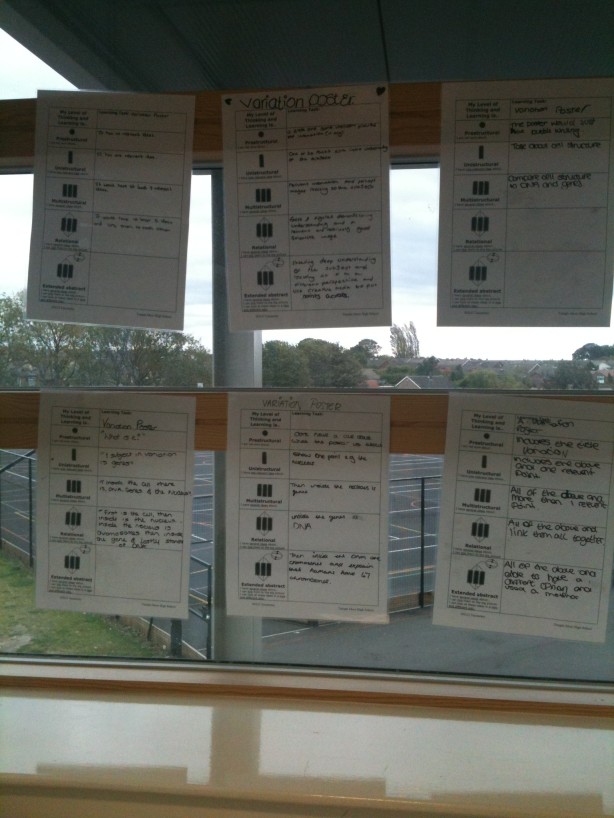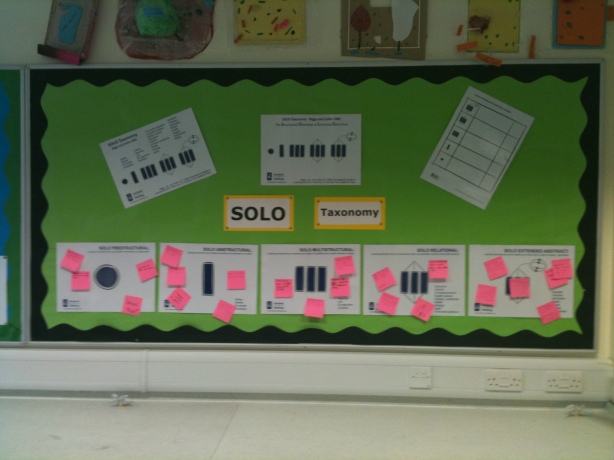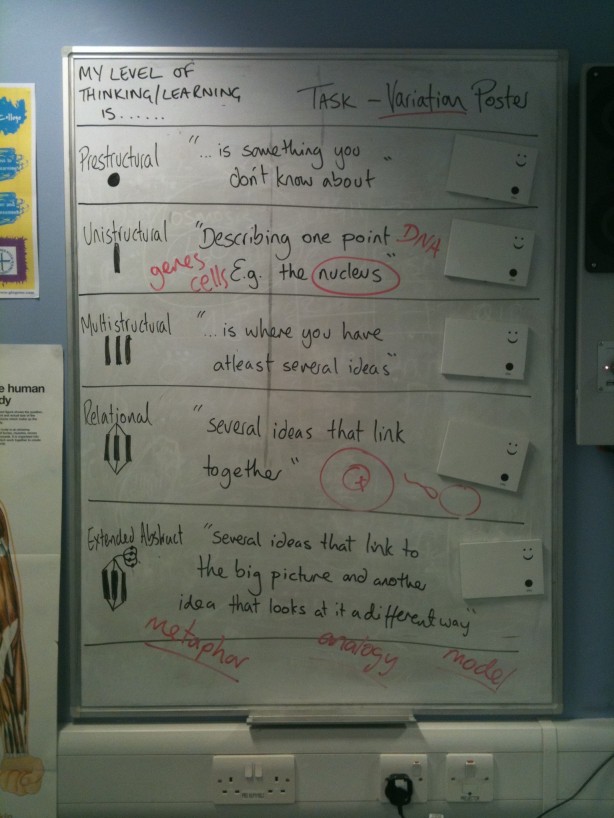This post would not have been possible without the help from DamianClark @clarky099 , Neil Watkin @nwatkin and the amazing Darren Mead @DKMead
SOLO Taxonomy is something that I have researched for a long while and now I’ve finally had the opportunity to try it out for real in the classroom – with, in my mind, staggering results.
For everything you need to know about SOLO Taxonomy please refer to the fabulous HookED website.
In a nutshell the taxonomy allows “.. the learner to think about the strengths and weaknesses of their own thinking when they are learning and to make thoughtful decisions on what to do next.” The taxonomy focusses on learning, is extremely student friendly, allows teachers and students to consider feed”forward” strategies, can be used for any learning context and above all is easier to use and understand than Bloom’s Taxonomy.
So the taxonomy itself….
We then publicised these onto the five stage of the Taxonomy as shown below (please don’t judge me on my borders, the Science Technician put them up for me and as every good Science teacher will tell you – never argue with your technician!)
Finally, the various ideas and thoughts were centralised by an identified group and transferred onto our SOLO Taxonomy board – this was now our success criteria. I used newly bought talking postcards to help the group collect the “best” statements from the class.
The next lesson I asked the students to create a poster on Variation …..yes I know a poster, but bear with me. I displayed an overview of what we have covered so far in the unit using Popplet then after asking them how long they required, set them off on the task (textbooks, workbooks and the knowledge/skills of each other were available).
Now usually when students create posters, a large majority of the given time is spent on producing the title in bubble writing (I’m sure that’s pretty common), but not this time, in fact it’s fair to say most of the “posters” were pretty scruffy – and why was this? Well, my students all wanted to get to extended abstract or at least relational – they wanted to show off their learning!
I then asked the students to peer assess each other’s work using our success criteria – at this stage I was uncertain as to if this experiment had worked – I should have listened to Dazza!
The feedback (or feed-forward) they gave each other was staggering, not only had they understood the taxonomy itself but they were able to use it to create specific and personal feedback to each other. I asked each student to write on the blank SOLO Taxonomy sheet (at the top of the post) stating where their partner was and what they needed to do to move on to the next stage.
I asked two colleagues to come and observe me using SOLO Taxonomy – they were so impressed with the students understanding and how it could be used effectively for assessment they are now trying it with their classes….
The futures bright, the futures SOLO.








[…] weaknesses of thinking when learning, and assists in thoughtful decision making on what to do next. (Tait Coles) So how had we done on the SOLO rubric? I was fairly pleased to see that my assessment of the […]
[…] weaknesses of thinking when learning, and assists in thoughtful decision making on what to do next. (Tait Coles) So how had we done on the SOLO rubric? I was fairly pleased to see that my assessment of the […]
[…] SOLO Taxonomy […]
[…] 2012 – The power of going SOLO: After reading the brilliant blog posts of Tait Coles, Darren Mead and David Didau a while back, I have been using their […]
[…] “Solo” journey began almost a year ago when I stumbled upon this blog post from Tait Coles (@totallywired77). I don’t want to regurgitate what others have already […]
[…] very similar to the different levels of SOLO. Just take a look at the mark scheme for Question 1, alongside Tait Coles’ SOLO taxonomy structure sheet: Mark scheme for Unit 1 Question 1, January 2012 SOLO taxonomy structure sheet by Tait Coles […]
[…] reading the brilliant blog posts of Tait Coles, Darren Mead and David Didau a while back, I thought it was about time I […]
This is like a moment of clarity for me! I have struggled for years with teaching through Blooms Taxonomy – this seems a much similar way to introduce students to the progression they are making especially as preparation for GCSE. In a bid to make my students more aware of their progression (and I am on a teaching indepedence mission at the moment) I know this will have some impact! Thanks
I’m glad it helped – let me know how you get on using SOLO feel free to follow me on twitter to contact me @Totallywired77
I tried this out today with year 11 for Literature’s Unseen Poetry – as a thought process. It worked relaly well – they were able to understand the benefit of having a thought process to follow.
Excellent stuff, glad it went well – as you quite rightly say it allows the students to understand their own learning. And allows them to answer the questions, what am I learning? How is it going? What do I do next? Are you on twitter?
Well I have been following Ian Gilbert’s Independent thinking skills for the last half term – Thunks, reducing speaking time etc. My current school, I hope, may have a grand push on independence soon – fingers crossed. I am constantly looking for new ideas for independence but it’s still a relatively “new” concept for the students at the moment. Anyone you can direct me to would be great. Unfortunately I am not “cool” enough for twitter – wordpress is currently my new toy!
Rubbish, twitter is very un-cool!! There are loads of people on twitter who can help and suggest ideas about independent learning. I’m doing a presentation on resilient learners at #tmclevedon where about’s is your school?
sounds interesting – any one in particular whose theories you are following for that? Manchester area my school – how about you?
Leeds. I would recommend following @DKMead @JamiePortman @pauldavidmac @ICTEnvagelist for starters!!
Thank you!
You have convinced me
Are you on Twitter yet then?
I made it yes – not really worked it yet #teachertrying
Haven’t seen any tweets yet?
not particularly sure how to get started
try this
let me know when you’re on twitter!
[…] reading the brilliant blog posts of Tait Coles, Darren Mead and David Didau a while back, I thought it was about time I […]
[…] to have a play and see what it could do for my students. I used a simple introductory task from Tait Coles blog which I adapted. (I couldn’t get away with Leeds FC- Sorry Tait!). It is fair to say the […]
If anyone is interested I have now posted on my next try with SOLO http://bit.ly/u7kWsj I am now hoping to use it as a method of setting differentiated learning objectives with my KS4 classes
Really great post – I recommend that SOLO Learners read this one!
I used this last week too! Pretty much your whole lesson (just changed Leeds United to West Ham united – and the facts of course!). The students were really able to see where their thinking was at (esp. as we are mixed ability) and we found that some of the brighter students could think well at higher levels yet struggled to articulate lower down the order at straightforward FACT level, which was interesting. It seems those students are quite good at grasping a bigger picture but it is often flimsy so they can write broad sweeping arguments but don’t tend to back them up with specific facts – now we can work on this 🙂
Thanks for sharing. I hope you keep on doing so.
Thanks Laura, really interesting to hear about students reaching the higher levels of SOLO but not having deep understanding of the lower levels. SOLO is fantastic at showing the level of thinking for students and creates opportunities for them to move on.
New post in pipeline……with videos!!
[…] SOLO Taxonomy – ENGAGED Learning! Feedback and FeedFoward on Learning Outcomes…nice template… This post would not have been possible without the help from DamianClark @clarky099 , Neil Watkin @nwatkin and the amazing Darren Mead @DKMead SOLO Taxonomy is something that I have researched f… Source: taitcoles.wordpress.com […]
[…] is a follow-up to the post I wrote a few weeks back – you can read it here if you […]
[…] Of course, there are other factors that have helped with this (for example, project based learning, SOLO taxonomy and Big Questions), but critiquing deserves the spotlight as a strategy that can have a profound […]
[…] came accross this interesting post from taitcoles last week. In the it he explained how he had used SOLO taxonomy with a Y9 group. As […]
Hello
you will be pleased to see that i used this in a Y10 geography lesson this morning. they had written a research based homework on the London docklands, I had marked it and I introduced the idea of SOLO when i handed the work back. I will add details of the lessons later on my blog http://www.whenisitdueinsir.wordpress.com but I really just followed your plan and the initial feedback suggests the pupils really like it! thanks very much
@dukkhaboy
Really interesting approach to establishing the SOLO taxonomy in lessons. Really liked the marking of exemplar work. Will add that into my lesson for Monday with Year 10. What I have found is that for most of this group (24 of the 29 in there) SOLO has created a really simple structure for them to improve the quality of their work quickly.
Think there will be enough practitioners for a SOLO teachmeet soon!
Thanks for your comment Neal.
I agree that the stages are really easy for students to understand – I think the simple images help.
A SOLO Teach-meet would be a great idea, or perhaps our own hashtag #solochat ???